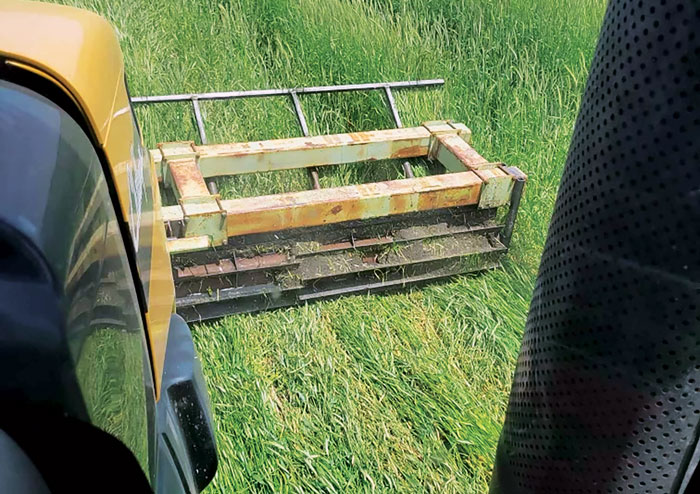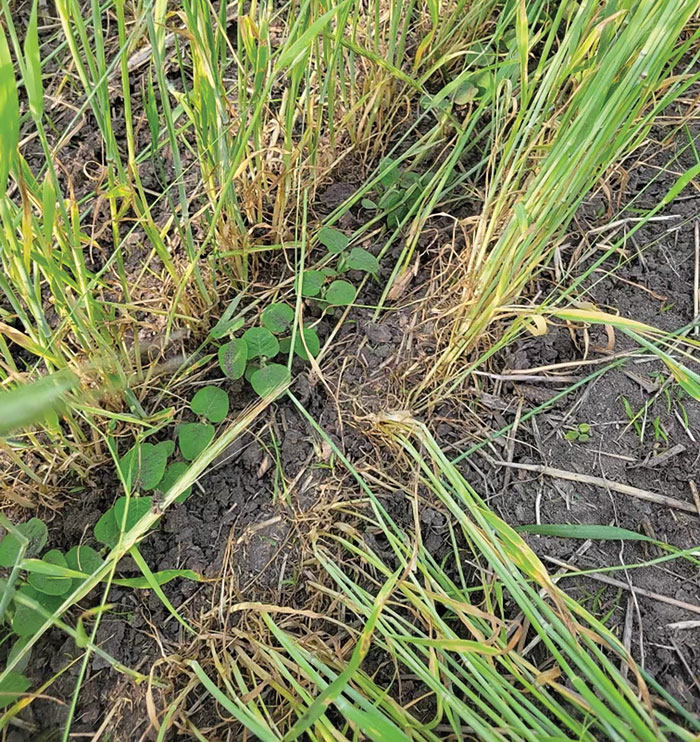When Mark Dobson was a kid, his granddad once told him, “You’re always about 20 years ahead of where you need to be, when we’re enjoying the moment.”
It turns out Granddad was right. The Donnellson, Iowa, strip-tiller is always thinking about the future of farming, which fueled his transition to an organic strip-till system 5 years ago.
“I toured some farms when I was in college, and the challenge of organic farming always intrigued me,” Dobson says. “I don’t know if organic is going to be the farming practice of the future, but I think there’s going to be a modified system that falls somewhere between what most people are doing now and a system with no chemicals. A lot of chemicals don’t work anymore anyways, so maybe I’m just getting a head start.”
“It’s not just about increasing yields, it’s about net dollars and learning where my ‘profit bushels’ are…”
Dobson strip-tills 420 acres of certified organic corn, soybeans and wheat, and he custom strip-tills 2,000 acres annually in southeast Iowa. He’s learned more in the past 5 years from his organic system than he has throughout most of his career as a custom farmer and agronomist.
“We always just fixed everything that was wrong with a chemical,” Dobson says. “On an organic farm, you must learn how to eliminate weeds from showing up instead of just thinking, ‘What can I spray to kill it?’ It’s made me far better as an agronomist. Before, I Band-Aided a lot, and yes, maybe $50 every year for the rest of your life fixes the problem, or maybe $200 once fixes it forever.”
Learning from Outliers
Long before Dobson dived into the world of organic farming, he and his dad no-tilled all their soybeans and some of their corn. The conventional corn acres consistently outperformed their no-till corn acres. Searching for a happy medium, they gave strip-till a try in the late 90s.
“We weren’t happy with our no-till corn yields and strip-till checked a lot of the boxes,” Dobson says. “We could band fertilizer and have a clean strip to plant into. And if you can make all your strips in the fall, you’re basically no-tilling in the spring and focusing on just planting. Strip-till has proven time and time again to have a yield benefit for both corn and soybeans.”

ON A ROLL. Dobson rolls cereal rye with his homemade roller-crimper. This method of cover crop termination has eliminated pigweed issues on his farm, he says. Mark Dobson
Surprisingly in the years since, Dobson has seen more gains with strip-tilled soybeans than corn. He started strip-tilling soybeans in 2008 after an accidental experiment produced surprising results.
“Back then, I had a rig that was ground drive and sometimes we’d have 5-10 acres left in a field,” Dobson says. “So, we just did some fields going to soybeans, and it was like, ‘Whoa.’ We applied some AMS, and the yield gain was significant enough that we tried it again, and since then I’ve always strip-tilled soybeans.
“Most of my life, the best learning experiences have been accidental. I’d like to say I have these beautiful, well-thought-out plans that hit a home run every time, but I’ve always learned more from outliers. If I get a spot in the field that’s 50 bushels better than everything else, I want to know why. And if I have a spot that’s dragging significantly, I want to know why. When everything is around the average, I don’t learn a lot.”
Strip-Till Strategies
Yields aren’t the only metric Dobson uses to measure profitability. Fewer field passes and less inputs are just as valuable.
“At the end of the day, it’s not just about increasing yields, it’s about net dollars and learning where my ‘profit bushels’ are,” Dobson says. “With strip-till, I don’t have to run as much nitrogen. I’m in that 0.6-0.8 pounds per bushel range ahead of soybeans, and with corn-on-corn, just because you’re planting directly on top of that band, I haven’t seen higher nitrogen rates pay me back. A lot of my corn acres only get 125-140 total units of nitrogen, and we’re growing 200-bushel corn consistently.”
Dobson runs a Zimmerman Manufacturing Contour King ST 12-row toolbar with a Montag dry fertilizer box. The unit allows him to make adjustments from the cab, which is a huge benefit in a custom strip-till operation that covers several different soil types and conditions across thousands of acres.
“I can release hydraulic pressure on the shanks and draw out what the issue is without even leaving the cab,” Dobson says. “I get up to 35% more done in a day because I can make adjustments from the cab to get through tough soil conditions without plugging.”
When it comes to fall vs. spring strip-till, Dobson says “good luck” if you’re trying to do all your acres at once. He targets his flatter, higher cation exchange capacity (CEC) soils with better nitrogen (N) holding ability for fall strips, and his rougher ground for spring strips.
“I get up to 35% more done in a day because I can make adjustments from the cab…”
“I prefer fall strip-till so I’m not making additional passes in the spring,” Dobson says. “I think every time we compact something in the spring, we give up some bushels, and it’s nice to be able to pull in and plant right away. But we have some highly erodible soils that we don’t want exposed all winter. I’d rather just wait until the spring to strip those fields.”
Dobson implements controlled traffic to cut down on compaction and soil disturbance. The way he sees it, only 6-8 inches of the 30 inches he’s farming are disturbed.
“I don’t move my strips much, only just enough to miss the root ball,” he says. “I use the same spot over and over again, basically just shifting enough to keep the strip-till bar from plugging. I place my fertilizer about 8-10 inches deep on my farm.”
Filling the Nutrient Gaps
Dobson uses hog manure for the main nutrient source on all his organic acres. He injects the manure 4-6 inches deep in 30-inch bands with a manure applicator in the fall and uses RTK technology to make strips on top of it usually in the spring.
“I’ve always found through my research as well, that you can get about 90% of the benefits of manure at about 50% the recommended rate,” Dobson says.
Dobson runs several tests on the manure to determine which additional nutrients need to be applied in the spring to “fill in the gaps” before planting corn and soybeans with his Case IH 1230 16-row planter.
“We sample the manure several times through the pump outs, and I ‘feather’ in what’s missing in the spring,” he says. “For example, if it needs 30 more pounds of phosphate, I’ll apply that with either the strip-till bar or the planter. If it’s low on potassium, I’ll apply some potash. I get the yield bump from manure at a lesser rate, and yield consistency from commercial fertilizer products, especially on the nitrogen side. I don’t see as high of yields on farms where they use only manure.”

SOYBEANS & RYE. Strip-tilled soybeans emerge next to living cereal rye. Dobson usually roller-crimps the cereal rye before planting, but this particular year he rolled the cereal rye after the soybeans emerged. “I’ve done it both ways, the soybeans don’t seem to care,” he says. Mark Dobson
Dobson works with Omaha, Neb.-based Midwest Labs to analyze his soil samples, which he pulls from both the middle of his strips and outside the strips. The types of nutrients he applies and rates vary annually based on the test results.
“I typically run more of a crop removal rate on my farm, basically fertilizing for the crop I expect to grow,” Dobson says. “If we have an awesome year, I’ll replace what crop we just grew to keep things in balance. I apply several elements, not just NPK. I apply a heavy amount of elemental sulfur in the fall because it breaks down over time and per unit it’s a very cost-effective way to ensure the crop has sulfur in season the following summer. There are usually 5-7 elements in my blend, including manganese, zinc, boron and gypsum. My rates come from long-term soil testing on my own operation.”
Cover Crop Strategies
All of Dobson’s organic acres have cover crops growing on them over the winter. He uses a custom-built 30-foot air seeder to frost seed clover into winter wheat and a John Deere no-till drill to plant cereal rye in the fall.
“I use cereal rye at high rates — 2.5-3 bushels per acre — ahead of soybeans because I’m using it as weed control in my organic system,” Dobson says. “Ahead of corn, the frost-seeded clover acts as a plant-based nitrogen source. It does a nice job of mineralizing and becoming available at about the time corn reaches its peak demand.”
Dobson makes strips through the cover crops and then terminates the cover crops with his homemade roller-crimper.
“Rolling rye at a heavy rate has eliminated pigweed issues on my farm,” Dobson says. “The one weed that everybody else fights, I don’t. That was a complete wild card for me because I wasn’t expecting that at all when I started doing this. I was just hoping for any kind of weed suppression I could get. Some guys might want to look at cover crops as a weed control option because if you’re going to spend $30 per acre to try and kill pigweed anyways, what’s wrong with having something growing on your field, preventing erosion and putting down a root mass that over time could potentially benefit your soil?”
“Rolling rye at a heavy rate has eliminated pigweed issues on my farm…”
Dobson admits his organic system is still in its “infancy stage” and he’s learning something new all the time. As if Dobson doesn’t have enough irons in the fire, he’s also using a 360 RAIN autonomous irrigation and nutrient application system for the first time in 2024.
“I’m applying some of my nutrients with it this year, and I think in the future I’ll be able to seed cover crops with it during the growing season,” Dobson says. “The machine goes up and down the field and can apply manure and water throughout the growing season. I made some manure passes with it on my organic corn. It’s going to make my head spin because there are so many different things I want to try and do with it. No matter how it works though, I’ll still strip-till to make up for what the manure lacks nutrient-wise.”
As Dobson works to improve his organic system, he’ll continue flexing his agronomist muscle and sharing strip-till knowledge with his peers and customers.
“The hard part for me is that people don’t dive more into the full benefits of strip-till,” Dobson says. “This is just my opinion, but I think some guys run too high of traditional fertilizer rates to get the yields they want to have. And the biggest challenge for me is getting guys to increase their sulfur rates. It’s hard getting people to change and realize that strip-till is a completely different system. Just because you were using a certain amount of fertilizer with a spreader rig doesn’t mean you should do the same with a strip-till bar.”







